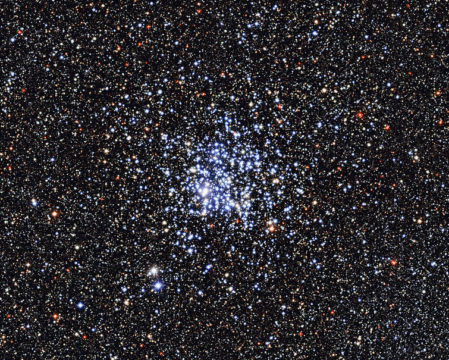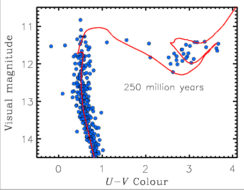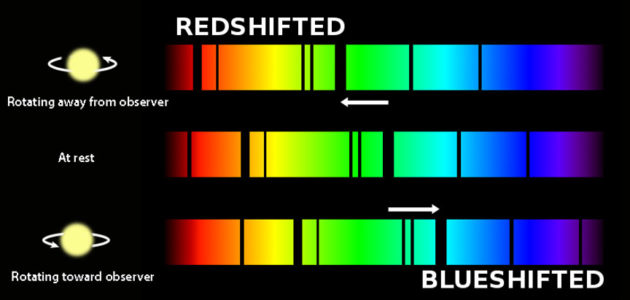Do star clusters form all at once or over several generations? A team of astronomers finds an answer among the spinning stars of an amateur favorite, the Wild Duck Cluster.

ESO
The Wild Duck Cluster or M11 is one of the most enticing telescopic sights in the summer sky. I can't count how many times I've gotten lost in its stellar maze. There are some 2,900 stars here — a rich assemblage of suns that for some resembles a flock of ducks in flight.
Astronomers have long believed that open clusters like M11 form during the gravitational collapse of a large cloud of dust and gas. Once the newborns start kicking, their gusty stellar winds clear the baby-faced cluster of remaining gas. Though their masses may differ and evolutionary pathways diverge, nearly all cluster members are thought to be born in a single generation and close in age.
Most of a star's life is spent on the "main sequence" burning hydrogen in its core, which produces the energy to shine as well as to resist the crushing force of gravity. When its core hydrogen is exhausted, the star switches to other fuels and burning strategies, causing it to expand, redden, and leave the main sequence. Young clusters may begin hot and blue, but their stars redden over time. As a general rule, a star's color is a good indicator of its age.

B. Lim et al. 2018
That's why astronomers couldn't make sense of why stars of similar brightness (and presumably of similar mass) in the Wild Duck Cluster displayed different colors. If open clusters are comprised of a single generation of stars of approximately the same age, why the color spread? Either M11 birthed a second generation of suns or something's missing in our understanding of how clusters form.
Enter Beomdu Lim (Kyung Hee University, South Korea). He led an international team of astronomers who used the Multiple Mirror Telescope in Arizona to examine the spectra of stars in M11 using Hectochelle, an instrument that can take spectra of multiple stars simultaneously. To their surprise, it wasn't the stars' ages that caused the spectral variety but their rotation. The team published their findings November 5th in Nature Astronomy.
As a star rotates, one side spins toward the Earth and the other away. Light coming from the side toward us is compressed and shifted toward the blue end of the spectrum; light from the half rotating away gets stretched out and shifted toward the red. Compression and stretching causes gaps in the star's spectrum to spread across a broader range of wavelengths (colors) instead of registering as a single hue.
"The effects of rotation on stellar evolution were often neglected in the past," says co-author Yaël Nazé (University of Liège, Belgium).

NASA with additions by the author
There were more surprises. Spectra revealed that the stars are spinning at different rates. The faster a star spins the better it mixes hydrogen into its core and the longer it can remain on the main sequence — 15% to 62% longer — compared to its slower rotating cousins of similar mass.
Notwithstanding that many stars redden as they evolve off the main sequence, fast rotators get a head start, appearing redder than slow rotators while still basking on the main sequence. Fast rotation also deforms a star's shape into an ellipse — as its equatorial diameter expands, equatorial regions cool and redden.
So we see that a range of stellar spin rates leads to differences in star color and ultimately stellar lifetimes. The Wild Duck Cluster has managed to mimic two stellar populations when only one exists. How does the old saying go? If it looks like a duck, swims like a duck, and quacks like a duck . . . it may not always be a duck. Something like that.
Reference:
B. Lim et al. "Extended Main Sequence Turn-Off Originating from a Broad Range of Stellar Rotational Velocities." Nature Astronomy. November 5, 2018. (free version available at arxiv.org)
 7
7









Comments
Rod
November 19, 2018 at 9:15 am
Bob, another good report here for small telescope users. I tested the views of M11 on 07-Jul-18 using my 90-mm refractor with 1.25 inch eyepiece and 10-inch Newtonian using a very good 2-inch eyepiece. WoW! No need to use the 90-mm for this open cluster now. When it comes to stars forming, initial rotation or spin rate is critical to model interpretations. The Sun for example according to standard model about 4.6 billion years ago, solar rotation rate about 2 or 3 days compared to a bit longer than 25 days at the solar equator today. I have observed sunspots that held together for a bit more than 12 days move across the Sun from W to E and disappear behind the limb. The sunspots were close to the solar equator. Very cool to witness star rotation directly (and safely) 🙂 The same is true for folks who have watched the Great Red Spot rotate into view on Jupiter. After 2 hours or so, the Great Red Spot is moving toward the central meridian of Jupiter or closing in on transit time. Real spin or rotation can be viewed by amateur telescopes.
You must be logged in to post a comment.
Bob KingPost Author
November 20, 2018 at 11:11 am
Hi Rod,
I appreciate your "spin" on this :))
You must be logged in to post a comment.
BobatBend
November 24, 2018 at 11:15 am
Bob,
This was a very interesting article on recent research. I glanced at the original article and appreciate how you were able to sift out the key points and rewrite them in a manner most amateur astronomers can understand. I do have one question for you...
If stars in this cluster illuminate in different frequencies (colors) due to their rotation direction and speed, how does this effect the Hubble theory which associates red-shift with stars speeding away from us? Will this new discovery cause astronomers to rethink the Hubble theory?
Thanks again for your insightful article.
Bob Mimiaga
You must be logged in to post a comment.
Lou
November 26, 2018 at 10:27 am
The color is due to their evolution rather than the Doppler effect (to see a change of colors visually would require relativistic speeds), so no re-think necessary. 🙂
You must be logged in to post a comment.
Bob KingPost Author
November 29, 2018 at 8:17 am
Hi Bob,
Hi Bob,
Thank you! I'm glad you enjoyed the article. Excellent question. Given the cluster's distance (located within the Milky Way Galaxy), the redshift you refer to from universal expansion doesn't come into play at this scale. At cosmological distances, when we reach the level of detail to see sun-like stars, I would assume redshift would then have to be factored in. PS. Thanks, Lou for your response.
You must be logged in to post a comment.
fif52
February 3, 2019 at 7:43 pm
is this about the stars inside or Messier 11. which have the spin?
You must be logged in to post a comment.
Bob KingPost Author
February 4, 2019 at 7:26 am
Fif,
Yes, it is.
You must be logged in to post a comment.
You must be logged in to post a comment.